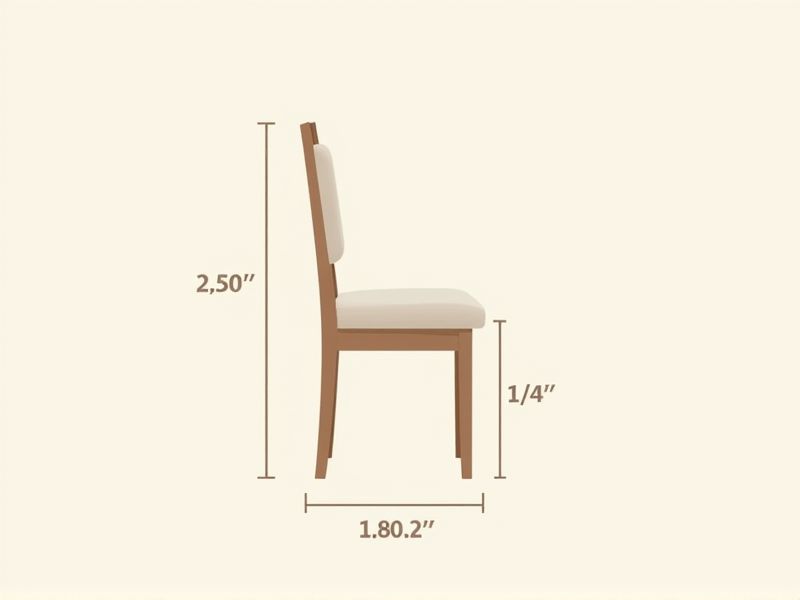
When choosing dining room chairs, standard dimensions help ensure comfort and compatibility with most dining tables. Typically, the seat height ranges from 17 to 19 inches from the floor, which pairs well with standard dining tables that are about 28 to 30 inches high. The seat width is usually between 16 to 20 inches, and the depth ranges from 16 to 18 inches, offering a comfortable sitting space for most adults. Keeping these measurements in mind will make it easier to select chairs that fit well in your dining area and provide a pleasant dining experience.
Seat Height
The standard seat height for dining room chairs typically ranges from 17 to 19 inches (43 to 48 cm) from the floor. This height accommodates most dining tables, which generally stand at 28 to 30 inches (71 to 76 cm) tall, ensuring comfort when seated. For optimal ergonomics, your knees should sit comfortably below the table with enough space for easy movement. When selecting chairs, consider the seat height in relation to your dining table to enhance your overall dining experience.
Seat Width
The ideal seat width for dining room chairs typically ranges from 18 to 20 inches, providing ample space for comfort during meals. Chairs that are too narrow may lead to discomfort, while those that are too wide can disrupt the table's flow. Ergonomically designed options often feature contoured seats to enhance support and encourage good posture. When choosing your dining room chairs, consider the dimensions of your dining table and the overall layout of your dining area to ensure a harmonious fit.
Seat Depth
The standard seat depth for dining room chairs typically ranges from 16 to 20 inches, ensuring optimal comfort for users of various sizes. A depth of 18 inches is often considered ideal, as it balances support and accessibility, allowing you to sit comfortably while also making it easy to stand up. When choosing a chair, consider that deeper seats may provide more comfort for taller individuals, while more shallow seats can seat shorter users more securely. Ensuring your chair adheres to these measurements will enhance your dining experience by promoting proper posture and relaxation during meals.
Backrest Height
The ideal backrest height for dining room chairs typically ranges from 14 to 18 inches above the seat, providing adequate lumbar support for most adults. A backrest that meets this standard ensures comfort during prolonged meals, reducing the risk of back strain. Consider choosing a chair with an adjustable backrest if multiple users will be seated, as this enhances personalized comfort. Your dining experience improves significantly when the chair backrest properly aligns with your natural posture.
Backrest Angle
The standard angle of a dining room chair backrest typically ranges from 90 to 110 degrees, providing an ergonomic design that promotes comfort during meals. Research indicates that a reclined backrest angle can enhance posture and reduce strain, contributing to a more enjoyable dining experience. An optimal backrest design supports the lumbar region, essential for maintaining spinal alignment, which is crucial for prolonged seating. When selecting your dining room chairs, consider models that offer adjustable backrest angles to suit different preferences and enhance overall functionality.
Armrest Height
The standard armrest height for dining room chairs typically ranges from 24 to 26 inches from the floor, accommodating most dining tables that are about 28 to 30 inches high. This measurement ensures that your arms rest comfortably while seated, promoting better posture during meals. Selecting chairs with adjustable or ergonomically designed armrests can enhance your dining experience, especially for taller individuals. When choosing your dining room chairs, be mindful of the space between the armrest and table edge to prevent discomfort while dining.
Armrest Length
The standard armrest length for dining room chairs typically ranges from 9 to 11 inches above the seat, providing optimal support and comfort. This height ensures that your arms rest comfortably while seated at the table, facilitating better posture and reducing strain during long meals. For dining chairs designed to fit under standard 30-inch high tables, measuring the armrest height allows for adequate clearance without hindrance. When selecting chairs, consider that adjustable options can further enhance your dining experience by accommodating various body types and preferences.
Leg Spacing
Dining room chairs typically feature a leg spacing of approximately 18 to 24 inches, ensuring stability and comfort. This spacing allows for easy movement and accessibility, accommodating various body types and dining table sizes. When choosing chairs, consider the height from the floor to the seat, which usually ranges between 17 to 19 inches, allowing for ample legroom. Proper leg spacing not only enhances aesthetic appeal but also contributes significantly to the overall ergonomic design of your dining space.
Overall Height
The overall height of a dining room chair typically ranges from 18 to 20 inches from the floor to the seat, ensuring comfort and accessibility for most dining tables. A well-proportioned chair should have a height that complements standard dining table heights, which generally vary from 28 to 30 inches. For optimal ergonomics, consider the clearance between the chair seat and the table surface; a gap of 10 to 12 inches is ideal. Ensuring your chair adheres to these measurements will enhance your dining experience and promote proper posture.
Material Durability
When selecting dining room chairs, prioritize materials such as hardwood, metal, or high-quality plastic for enhanced durability. Chairs made from solid oak or beech typically last over 10 years with proper care, ensuring a long-term investment. Upholstered options often utilize fabric blends or leather finishes that resist wear and tear, further increasing their lifespan. Choosing chairs with reinforced frames and sturdy joints can support weights up to 300 pounds, enhancing overall stability and safety during use.
